|
Infant Mortality and Social Context
Roelfien Haak; Héctor Bejar
CEDEP
Mortality of children in Latin American
is not isolated from the economic and social context of
the region. In fact, infant mortality is a result of the
living conditions experienced by a majority of the
population.
Latin America is currently undergoing
the implementation of so–called "structural
adjustment", a type of program recommended to the
countries’ governments by international financial
organizations as a condition for receiving loans. Gaining
control of inflation, a primary objective of structural
adjustment, is indeed positive and necessary. In itself,
however, structural adjustment cannot guarantee that
control of inflation can be sustained, nor does it put
Latin American societies on the road to being less
discriminatory and exclusionary than they already are.
Latin American productive employment
has still not managed to move out of recession, with 2%
GDP growth continuing to be less than the 3% growth of
its economically active population. Unemployment has
moved above 7% throughout the region, and
under–employment continues to grow steadily. With 15
million new "jobs" in the region from 1993
through 1995, 13 million are in the informal sector. In
Latin America, this is a form of survival at the most
basic level of existence. Poverty is growing. It is
increasingly affecting the middle classes; it is
primarily threatening women; it is seriously affecting
the well–being of the children of Latin America.
This regional reality is dramatic in
Peru. Despite the publication of official figures showing
spectacular growth of the gross national product as
compared to 1990, when viewed from a longer historical
perspective, the country is at 1984 production levels in
real terms. Peru has paid a high social cost for a result
that is still insufficient and precarious. Social
inequities have worsened and wealth has become more
concentrated, with Peruvian and multinational companies
capturing 42% of the national income in 1994.
Consequent to the structural adjustment
programs, poverty is now a mass phenomenon in Peru.
Though official figures speak of an encouraging decrease
in poverty in specific areas, at the current pace it
would take hundreds of years for the social phenomenon of
increasing poverty to disappear. While 60% of the
population already lives in extreme poverty,
underemployment continues to expand. At the present time,
almost 80% of the economically active population is
experiencing increasing poverty.
The government’s acknowledgment of
the detrimental social consequences of its structural
adjustment program has been slow and insufficient.
Payment of the foreign debt continues to command the
majority of public funds. While special funds to fight
poverty, particularly FONCODES, have been growing, these
funds are allocated primarily for the development of
infrastructure. The average spending for essential basic
services continues to be low and flagging, as measured
against population growth and the unmet needs of the
people, especially in health and education. Funds which
are available are allocated in a centralized and
undemocratic manner, without real participation of local
governments and communities. In the best of
circumstances, local recipients are put in the role of
applicants and beneficiaries; they are not actors and
decision–makers.
Following is data which supports these
assertions.
Deceleration of GDP Growth in Latin
America and the Caribbean
Latin America’s economic growth
has been decelerating and continues to be less than would
be necessary to recoup the preceding "lost
decade" of the l980s. The International Labor
Organization has defined 1995 in Latin America as "a
year of fragile economies with setbacks in
employment".1
The vulnerable economic recovery that
began to control inflation through so–called
structural adjustment has been interrupted.
Further adjustments had to be made to
deal with the volatility of short–term capital
fostered, in part, by those same programs.
Product growth has fallen off and is
now in the area of 1.5% to 2.%. This is approximately
half the average recorded in the 1990–1994 period
and lower than the growth of the economically active
population, which is in excess of 3% per year.
Graphic 1. Latin American GDP
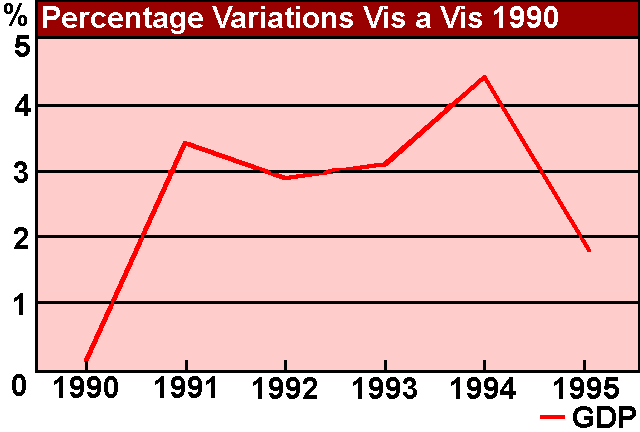
ILO. Official Statistics
Growth of EAP Exceeds GDP Growth
The growth in employment has been less
than the expansion of the non–farm economically
active population, which was 3.3% per year during the
1990–1995 period. Outpacing growth in employment,
this has generated a continuing employment gap. The
increase in open unemployment averages 6.4% in 1994; the
increase in underemployment and the informal sector is
shown in other charts.
Graphic 2.EAP in Latin American
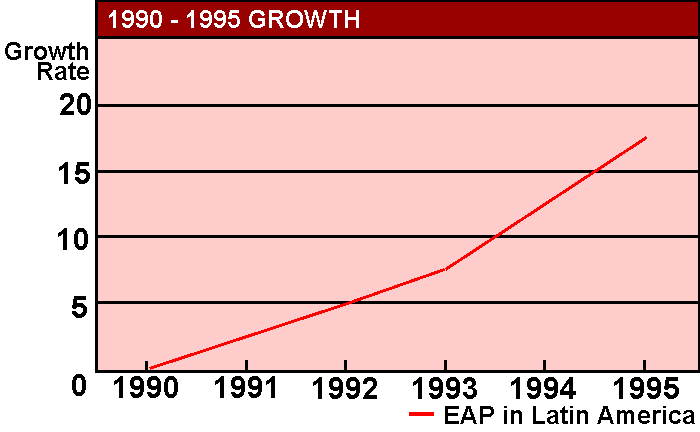
ILO. Based on household
surveys.
New Jobs are in Low Productivity
Categories and Provide Low Income
An insufficient number of new jobs have
been created in Latin America. This has been caused by
economic policies which discourage production and favor
the decline of local industrial initiatives.
The jobs which have been created are,
for the most part, low in productivity and low in income
generation. The correlation is the expansion of the
informal economic sector. Out of every 100 new jobs, 94
are in the informal sector, accounting for 57% of the
persons with jobs in the region.
As a result, while it is true that
inflation fell from 73% to 18% in 1995, real income has
decreased by –2.4% in the region as a whole.2
Graphic 3. Latin American new
jobs

Source: ILO
Social Inequity in the Distribution of
National Income
The distribution of national income in
Peru is one of the most uneven in Latin America. While
company income represented 42% of national income in
1994, worker income from wages amounted to only 19%. The
chart shows that this practice has continued through
recent years (see Graphic 4).
Poverty Affects the Majority of the
Peruvian Population
As a result of unequal distribution of
national income, aggravated by the structural adjustment
program currently underway, a majority of the Peruvian people are poor. According to 1994 official
figures, 63.5% of the population lives in poverty
conditions, with 17.7% being extremely poor.3 In spite of this, official figures describe a
relative decrease in poverty. These figures, in part,
reflect changes which have been made in the criteria and
methods for measuring poverty and extreme poverty (see
Graphic 5).
Graphic 4. Distribution of
national income. 1992-1994 period.
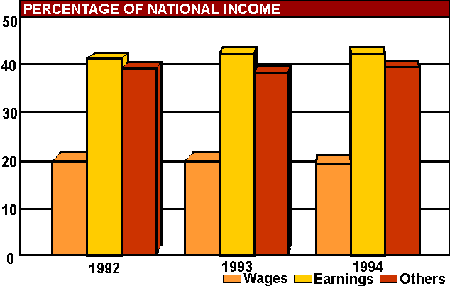
Sources: INEI, BCR, GRUPO PROPUESTA
Graphic 5.Evolution of poverty
in Peru. 1990-1994 period.
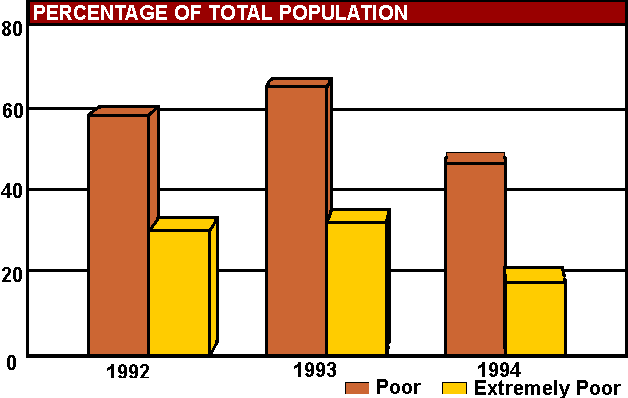
Source: ENNIV, FONCODES
Massive Underrmployement
The massive layoffs caused by the
structural adjustment programs, coupled with an
insufficient and diminishing supply of jobs in private
industry, have resulted in increasing
under–employment. In 1995, almost 80% of the
economically active population made an income well under
the minimum living wage.4 This
trend toward massive un– and under–employment
has been advancing since the start of the 1990 structural
adjustment program (Graphic 6).
Graphic 6. Unemployment and
underemployement. 1992-1995 period.
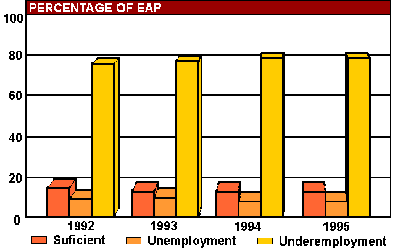
Sources: INEIV, BCR
Graphic 7.Types of spending
in Peru (As percentage of GDP)
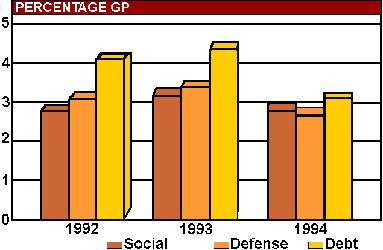
Source: BCR/Prepared by: Eduardo
O´Brien.
Social Spending in Peru’s 1996
Budget
The public spending budget totals
22,898 million Peruvian soles, equivalent to US $9,955
million. This is a contraction in real terms of 6%
compared to the previous year. Earmarked for the social
sector is 8,160,460 thousand soles (U.S. $3,556,721). In
relative terms, this is 35.7% of total public spending.
This sum includes bureaucratic remunerations and
infrastructure costs.
Budget allocations for payment of the
foreign debt continues to exceed social spending,
currently totalling 48.3% of the federal budget.5
Graphic 8. Concentrated budget
execution. Percentage structure by sector.
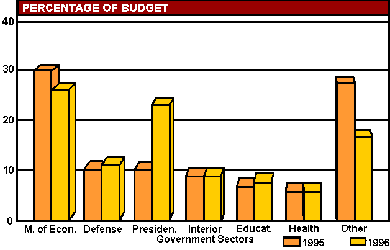
Peru´s Budget 1995-1996
Concentration in the Ministry of the
Presidency
The power for budget allocation is
concentrated in the Ministry of the Presidency. This
makes the 1996 budget even more critical.
In 1996, this Ministry accounts for 23%
of central government resources –more than double
its percentage in 1995. The high proportion of resources
concentrated in the Ministry of the Economy is explained
by the fact that foreign debt payments are made by that
Ministry.
Social Spending Deaggregated for
Bureaucracy and Infraestructure
Official Peruvian government figures
show a considerable increase in social spending in the
General Budget for the Republic.
Nevertheless, it should be taken into
account that:
1. The official definition of social
spending is extremely broad, including all expenses of
the Judiciary and of the Ministry of Labor, Education
(including higher education, which is not accessed by the
poorest) and Health, plus expenditures for special
programs to alleviate poverty.
2. Specific programs geared to poverty
alleviation have grown since 1990, but they have done so
at the expense of education and health, which have not
grown significantly.
3. In 1995, no less than 70% of poverty
program spending was allocated to bureaucratic support
and the financing of infrastructure development. Basic
services remained at their low traditional averages (see
Graphic 9).
Infant Mortality Trends in Peru
The infant mortality rate in Peru is
the third highest in the region after Bolivia and Haiti.
The 1994 rate was estimated to be 52 per one thousand
live births. This means 34,000 deaths per year of infants
under one year of age.
At the outset of this decade, reduction
of infant mortality was one of the goals which moved
civil society and the state to undertake significant
joint action at both national and international levels.
The Declaration of the World Summit for
Children held at United Nations headquarters on September
30, 1990 sealed these agreements with commitments for
targets to be reached between 1990 and the year 2000. One
of these targets is the reduction of the mortality rate
for children under one year of age (IMR) and children
under five years of age by one–third—cutting
the figures to 50 and 70 per 1000 live births,
respectively.
Peru signed this agreement and each
year holds "Children’s Week" to follow up
on the achievement of the goals set forth in the National
Action Plan for Children.
The infant mortality rate has been
reduced by 50% nationally over the past 20 years, with a
1993 estimate of 58.3 per thousand live births. This
trend, however, which on the whole continues to be high,
is not evenly distributed over the entire country.
In 1993 the risk of dying during the
first year of life was more than double in rural areas as
compared to urban areas. The IMRs by department or
province reveal that while Callao had a rate of 21, in
Cusco, Puno and Huancavelica the average varied from 82
to 96 per thousand live births. This unequal dispersion
of infant mortality rates is not reflected in the
national averages.
Moreover, the behavior of these
indicators showing health improvements was not the same
over time in the country’s different population
centers. The difference between the provinces and the
national average during the 1972–81 decade was much lower than
that found for 1981–93.6
The more significant differences in the
health status of extreme population groups, i.e., the
broadening of epidemiological gaps, show that the
national indicators fail to express a heterogeneous
health reality. Three health indicators have improved in
the long term: the infant mortality rate, the fertility
rate, and life expectancy.
Nevertheless, health indicators
expressed as national averages mask the enormous
differences existing within the country. Various factors
have been involved in the reduction of infant mortality
in Peru over the past decades, including a drop in
fertility, an increase in women’s education, mass
communications, migration to urban areas where the supply
of health institutions and professionals is greater, and
an increase in access to health services.
Graphic 9.Operation, bureaucracy
and infrastructure, percentages for total of each sector
in 1995 public spending.
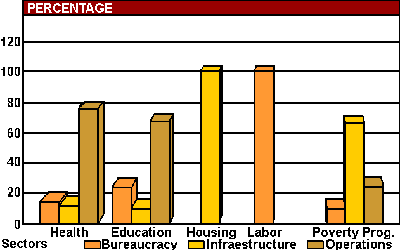
Preparation: Eduardo O´Brien
The Causes of Infant Mortality
Being a child was risky in Peru in
1994.
* Deaths of infants under 1 year of age
were caused by perinatal origin, acute respiratory
infections, diarrheic illnesses, nutritional
deficiencies, and congenital anomalies.
* Deficient pre–natal care and inadequate care in
deliveries caused perinatal problems such as low birth
weight, which is estimated at 8.8% nationally.
* Recently the incidence of immuno–preventible
diseases has dropped significantly, due to the high
immunization coverages attained.
* In the 1–4 years of age group, acute respiratory
infection (ARI) (6 to 12 episodes per year, first cause
for consultation, pneumonia chief cause of death) and
diarrheic illness were the chief causes of illness and
death.
* Caloric–protein malnutrition constitutes an
important cause of death and disability in this group and
is projected to the 6–9 years of age group, where
chronic malnutrition affects 48% of the population.
Anemia due to iron deficiency affects 20% of children.
Among the chief determinants of malnutrition are: short
duration of lactation, food insecurity of poor families,
maternal illiteracy, lack of nutrition education, and
high prevalence of diarrhea and ARI.
It is important to note the changes
that have taken place in this situation over the last 20
years.7
Primary causes of mortality in children
under five years of age:
* diarrheic diseases
* respiratory illnesses
* illnesses associated with prenatal period
* severe malnutrition
Primary causes of mortality in children
under one year of age:
* immuno–preventible diseases
* diarrheic diseases
* respiratory illnesses
The reduction in the mortality rate was
accompanied by modifications in the structure of causes.
Among the latter was the effect of broadening
immunization coverages, supported by a program organized
by the government, international cooperation
organizations and grassroots social organizations, in
particular omen organized by neighborhood and through
collective survival endeavors ("Glass of Milk"
Committees, Mothers Clubs, people’s kitchens) and
NGOs.
Among children under five years of age,
mortality causes linked to poverty become more acute,
particularly nutritional insecurity and low provision of
mother–child care.
Mother and Child Health
* Being a mother is a health risk.
* 50% of the female population are women in the fertile
age group (15–49).
* The maternal mortality rate in 1991 was 261 per 100,000
live births.
* Approximately 15% of maternal deaths are of adolescent
mothers, among whom there is also 20% of deaths due to
abortion.
* 65% of expectant mothers receiving prenatal care have
not had any tetanus vaccine.
IMF Comments on Peruvian Social Policy
In 1994, the technical assistance
mission of the Public Finance Department of the
International Monetary Fund prepared a diagnosis of
poverty situation, public policies and public spending
management in Peru, in response to a request made by the
President of the Republic. The mission indicated, among
other things, that:
* the data on budget execution are very
poor;
* there is a need to improve the quality of education
services, as well as to improve access to same by the
poor;
* in health and nutrition there is considerable
duplication of functions among the different agencies of
the central government, non–governmental
organizations and regional and municipal governments in
the provision of health services and nutrition programs.
Despite this, the coverage of same is still very limited;
* the nutrition programs do not cover the most vulnerable
and highest risk groups;
* most of the food assistance programs do not reach the
most needy groups;
* the extreme budgetary weakness of the line ministries
contrasts with the strength and power of the ministry of
the Presidency?8
The Role of Multilateral Agencies
Multilateral finance agencies promote,
support and finance the economic structural adjustment
program currently underway and try to downplay its
negative social effects by financing special and focused
programs to combat extreme poverty. The real effect of
these programs is still very much open to debate, since
no assessment of their impact has yet been made.
On the other hand, non–financial
technical multilateral agencies, such as the UNDP, ILO or
UNICEF, maintain different viewpoints, but their role is
far from decisive.
"It is very clear, even from a
superficial examination of social policy in Peru, that
agencies like the World Bank, IFM and IDB play an
important role in the formulation of those
policies," indicates the specialist Rosemary Thorp,
who made an assessment of Peruvian socio–economic
reform.
"There are some problems,
however, with this dependence on multilateral agencies.
One is that policy making may become passive and
dependent on the recommendations of foreign agencies.
Another is the creation of external islands within the
line ministries, not entirely under ministerial control
and with higher salaries than the majority of ministry
employees. There is also the possibility of a lack of
coordination among the agencies themselves and
duplication of efforts, as well as application of
contradictory policies...
... Although the resources provided
by multilaterals may very well be necessary at the
initial stages of the reform process, there is a limit as
to how far or how much it is desirable for Peru to
increase its level of external indebtedness with loans
for social development.
... We have frequently emphasized
... the weakness of the Peruvian State and society. But
there are also strengths. There is a broad network of
community and local organizations that represents a
powerful potential force in a coordinated strategy. There
are also growing signs of the potential for cooperation
with the private sector. Such coordination and
cooperation can only be achieved if the central
government acknowledges the strength of those organizations and of NGOs, and consciously
involves them in a comprehensive national effort."?9
Participation of Civil Society
In Peru there are no formal or
institutionalized linkages between government agencies
and civil society organizations. Efforts along this line
are isolated or exceptional. Grassroots or citizen
orgnizations have no participation in the on–going designing of policy, its definition or application, and
the government fails to take advantage of their rich and
varied experiences. Decision–making and monetary
resources are centralized in the ministry of the
Presidency.
The Inter–sectorial Commission on
Social Affairs has had a very secondary and almost
nonexistent role. This Commission has a Technical
Secretariat whose basic work has been the Plan for
Improved Social Spending or the focusing of such spending
on pockets of extreme poverty. Civil society
organizations do not have any type or representation on
this Commission.
TABLES
IMR - PERU
|
|
1992 (1)
|
1993 (2)
|
1994 (3)
|
|
National
|
55
|
58.3
|
52
|
|
Urban
|
40
|
40
|
36
|
|
Rural
|
78
|
83
|
74
|
1 ENDES II.1991–92, INEI, page 89.
2 1993 National Census, INEI.
3 CUANTO, Perú en Números 95. Projected rate, page 240, August 1995, Lima, Peru.
Infants Mortality Rate per Thousand Live Births
|
A:L:C:
|
IMR
|
|
|
|
% of MR5
|
|
|
|
1990
|
|
1993
|
|
|
|
|
Haiti
|
92
|
|
85
|
|
65
|
|
|
Bolivia
|
102
|
|
78
|
|
68
|
|
|
Guyana
|
52
|
|
54
|
|
86
|
|
|
Guatemala
|
54
|
|
53
|
|
73
|
|
|
Nicaragua
|
56
|
|
51
|
|
71
|
|
|
Brazil
|
60
|
|
52
|
|
83
|
|
|
Peru
|
82
|
|
43
|
|
69
|
|
|
Peru
|
|
|
58.3 *
|
|
|
|
|
Maximun
|
102
|
|
85
|
|
90
|
|
|
Minimum
|
11
|
|
9
|
|
65
|
|
|
Mean
|
40
|
|
28
|
|
84
|
|
|
Less developed
|
|
|
111
|
|
64
|
|
|
Developing
|
|
|
69
|
|
68
|
|
|
Industrialized
|
|
|
9
|
|
90
|
|
|
Sub–Saharan Africa
|
|
|
109
|
|
61
|
|
|
South Asia
|
|
|
87
|
|
68
|
|
|
Arab States
|
|
|
53
|
|
76
|
|
|
L. A. & Caribbean
|
|
|
38
|
|
79
|
|
|
East Asia
|
|
|
42
|
|
75
|
|
Source: UNICEF - Estado Mundial de la Infancia, 1992 and 1995, taken from Estadísticas para América Latina y el Caribe. UNICEF, Regional Office for Latin America and the Caribbean. May 1995.
* 1993 National Census, INEI, Peru.
IMR Evolution - Peru: 1993 National
Census
|
Evolution
|
|
|
|
|
IMR
|
1972
|
1981
|
1993
|
|
|
109.2
|
81.7
|
58.3
|
|
Evolution of socio–cultural indicators
|
|
|
|
|
|
1972
|
1981
|
1993
|
|
Urban Population
|
60
|
65
|
79
|
|
Secondary and above pop.
|
25
|
42
|
56
|
|
Housing w/o plumbing
|
73
|
56
|
40
|
IMR by Departament. Period: 1990 - 1995 Quinquennium
(Selection of 3 of the 25 Departments of Peru and Callao Province)
|
|
IMR
|
|
National
|
76
|
|
Lima
|
45
|
|
Callao
|
41
|
|
Huancavelica
|
130
|
|
Ayacucho
|
107
|
Source: Social Investment Map, FONCODES - UNICEF, 1994: En. page 23.
Women´s Health*
|
1990
|
MMR
|
Births attended by specialized personnel
|
|
Haiti
|
340
|
20
|
|
Bolivia
|
332
|
55
|
|
Peru
|
298
|
52
|
|
Cuba
|
36
|
90
|
|
Chile
|
34.5
|
98
|
|
Costa Rica
|
26
|
93
|
Source: Statistics for Latin America and the Caribbean, UNICEF, Regional Office. May 1995, page 24.
Preparation: FOVIDA, January 1996.
* The three highest and three lowest maternal mortality rates in Latin America and the Caribbean.
Notes:
Charts prepared by
Eduardo O'Brien.
1 ILO. Panorama laboral 1995, Avance del panorama
laboral de 1995, primer semestre.
2 Ibid.
3 Encuesta Nacional de Niveles de Vida, ENNIV
1994.
4
National Statistics Institute, Central Bank.
5 O’BRIEN Eduardo and SIERRA Juan. Análisis
y alternativas del gasto social para 1996. Grupo
PROPUESTA.
6 Lineamientos de Política de Salud
1995–2000: Un sector Salud con equidad, eficacia y
calidad. Ministerio de Salud. December 1995. Lima, Peru.
7 Tavera, Mario: "La mortalidad infantil,
estructura, tendencias e implicaciones para la situación
de salud", paper presented at the Seminar on Infant
Mortality in Peru and analysis of the health situation.
INEI, MINSA, UNICEF. September 1994.
8 AHMAD Ehtisman et al. Peru: pobreza, politicas
publicas y gestión del gasto publico (Aide memoir).
Department of Public Finance of the International
Monetary Fund. April 1994.
9 THORP, Rosemary et al. Challenges for Peace.
Towards Sustainable Social Development in Peru. Report of
the Pilot Mission on Socio–Economic Reform of the
Inter–American Development Bank. Social Agenda
Policy Group, April 1995.
|